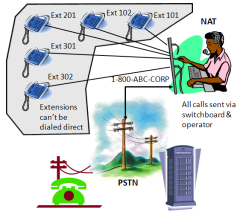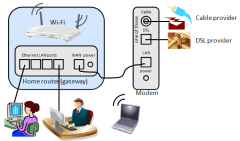






8.2. Home Networking [src]
A home network or home area network (HAN) is a residential local area network (LAN). It is used for communication between digital devices deployed in the home, usually a small number of personal computers and accessories, such as printers and mobile computing devices. LANs are typically larger and are managed by IT professionals. Even a small office LAN, with tens of computers, probably has an IT person — often a paid consultant, but also often a computer literate employee. (SRU's LAN is at the opposite end of the scale: the LAN covers almost one square mile, supports thousands of computers, and is managed by network professionals; so, it closer to a MAN.) At home this task is often handled by the most computer literate family member – the one who uses it the most – very often a teenager.
An important function of a home network is the sharing of Internet access, often a broadband service using a fiber-to-the-home, cable TV, Digital Subscriber Line (DSL) or mobile broadband Internet Service Provider (ISP). Generally the ISP only provides one IP address and uses a router with a NAT proxy server (see sidebar), which allows several computers to share the same IP address. The router may be emulated by a PC with several network interfaces, but today a dedicated hardware router is more common, often including a wireless access point and providing WiFi access.
A home group is a feature that allows shared disk access, shared printer access and shared scanner access among all computers and users (typically all family members) in a home, in a similar fashion as in a small office workgroup, i.e. by means of distributed peer-to-peer networking (without a central server). Additionally, a home server may be added for increased functionality.
A Windows HomeGroup is a new feature in Microsoft Windows 7 that simplifies file sharing. All users (typically all family members), except guest accounts, may access any shared library on any computer that is connected to the home group. Passwords are not required from the family members during logon. Instead, secure file sharing is possible by means of a temporary password that is used when adding a computer to the HomeGroup.
Network Address Translation
If you've ever had reason to look at the actual IP address of computers on your home network, you probably found that they are amazing similar to that of other people (perhaps, 192.168.1.10). That's because the IP address is like a phone extension. To the outside world, all calls pass through an operator, after dialing the main number, who then connects you to the appropriate phone. Calls from the inside to the outside also go through the operator.
NAT does the same thing for Internet traffic, so your entire network appears as one IP address to the outside world. (That's good because we have run out of IPv4 addresses.) The number you recognize is basically an "extension" within the network.

NAT switchboard analogy
By Paul Mullins: constructed
Physical transmission media
Home networks may use wired or wireless technologies, or a combination. Wired systems typically use Category 5 (CAT5) or Category 6 (CAT6) Unshielded Twisted Pair cabling. Less commonly, other variations of twisted pair, coaxial cable, or the existing electrical power wiring is used.
One of the most common ways of creating a home network is by using wireless radio signal technology; technically an 802.11 network. A wireless network can be used for communication between many electronic devices, to connect to the Internet or to wired networks that use Ethernet technology.
Most products that are wireless-capable operate at a frequency of 2.4 GHz under 802.11b and 802.11g or 5 GHz under 802.11a. Some home networking devices operate in both radio-band signals (dual band) and fall within the standard 802.11n. Since these need to match the abilities of the various devices in the network, dual band is currently the best choice. Although sometimes used as a generic term for wireless, Wi-Fi is a marketing and compliance certification for IEEE 802.11 technologies. The WiFi Alliance has tested "compliant" products and certifies that they will work together. (By the way, there is argument about whether WiFi stands for wireless-fidelity – a meaningless term – or was just a play on stereo Hi-Fi.)
The latest major standard is 802.11ac which extends 802.11n. The specification has multi-station throughput of at least 1 gigabit per second and single-link throughput of at least 500 megabits per second (500 Mbit/s).

Ethernet & Wireless home network
By Lucid (Own work) [GFDL or CC-BY-SA-3.0-2.5-2.0-1.0], via Wikimedia Commons
The Institute of Electrical and Electronics Engineers (IEEE) has set many communication and networking standards in current use.
Power-line networking is relatively new. With the installation of a home networking device, the network can be accessed by simply plugging the computer into a wall socket. The ITU-T G.hn and IEEE Powerline standard, which provide high-speed (up to 1 Gbit/s) local area networking over existing home wiring, are examples of home networking technology designed specifically for Internet Protocol TeleVision (IPTV) delivery. Recently, the IEEE passed proposal IEEE 1901, a standard for high speed (up to 500 Mbit/s at the physical layer) communication devices via electric power lines, often called broadband over power lines (BPL). IEEE 1901 replaced a dozen previous powerline specifications.

Power line network device
By Tim Walker from United Kingdom (HomePlug 85Mbps adapterUploaded by Partyzan_XXI) [CC-BY-2.0], via Wikimedia Commons
 How Stuff works: Power line networks
How Stuff works: Power line networks
 #141 The Power of Power Line Networking
#141 The Power of Power Line Networking
Home Network Devices
Infrastructure Devices
A broadband modem is used for connection to the internet. This is typically either a DSL modem using the phone line, or a cable modem using the cable internet connection (but could also connect to fiber or broadband wireless).
A residential gateway (sometimes called a broadband router) connects the broadband modem to the rest of the network. This enables multiple devices to connect to the Internet simultaneously. Residential gateways, hubs, and wireless access points (and sometimes broadband modems) are often combined and sold as a device.
A wireless access point is used for connecting wireless devices, if the network is not completely hard-wired. Typically, the radio signal is converted to wired Ethernet. As noted, this functionality is often included in the gateway (router).

Home Network Infrastructure
with the gateway and wireless access point in one device (as is typical)
By Paul Mullins: constructed
Client Devices
- A PC, or multiple PCs including laptops, Netbooks, and Tablet PCs
- Entertainment peripherals — an increasing number of devices can be connected to the home network, including DVRs, digital audio players, game machines, stereo system, and an IP set-top box, as well as TVs themselves.
- Internet Phones (VoIP)
- Smart Phones connected via Wi-Fi.
- A network bridge, which connects two networks together, often giving a wired device, e.g. Xbox, access to a wireless network.
- A network hub - a central networking hub containing a number of Ethernet ports for connecting multiple networked devices
- A network attached storage (NAS) device can be used for storage on the network.
- A print server can be used to share printers among computers on the network. (A PC may act as a print server and/or file server.)
Home networking data rates
Data rates depend on the equipment used and the environment it is used in. Wireless is especially sensitive to environmental conditions that include the location of the wireless access point (and client), distance, intervening walls or floors (and their makeup), and radio interference from wireless phones, microwaves, and nearby wireless networks. Distance and interference can occur with any medium, though fiber (in the home) is relatively unaffected. Maximum data rates, sometimes called bandwidth, is often stated for "laboratory conditions". The numbers below are considered reasonable.
- Ethernet Category 5 cable, Category 6 cable
- Common rates are 10 Mbps, 100 Mbps, and 1 Gbps at distances up to 100m (328 feet).
- Wi-Fi Wireless LAN connections [src]
-
802.11b: 2-3 Mbps with 5-6 Mbps possible
802.11g: 20 Mbps
802.11n: 40-50 Mbps with 70-80 Mbps possible in homes
802.11ac: 70-100+ Mbps dependent on signal strength. - All home wiring (coax, powerline and phone wires)
- A future standard for speeds up to 1 Gbit/s being developed by the ITU-T.







